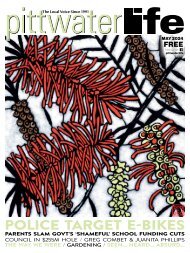Pittwater Life June 2022 Issue
- No tags were found...
Create successful ePaper yourself
Turn your PDF publications into a flip-book with our unique Google optimized e-Paper software.
Garden <strong>Life</strong><br />
Garden <strong>Life</strong><br />
Just leave it – the tough-as-nails<br />
plant that can tolerate neglect<br />
Over 100 years ago The<br />
Cast Iron Plant (main)<br />
was one of the most<br />
popular plants in Victorian<br />
conservatories. For many<br />
years Aspidistras were a<br />
forgotten indoor plant but<br />
recently, not surprisingly, they<br />
have regained their popularity.<br />
The name<br />
describes them<br />
well. They are<br />
tolerant of<br />
neglect, dryness,<br />
low light,<br />
heaters and air<br />
conditioning<br />
and only need<br />
to be re-potted<br />
every three<br />
or four years,<br />
nevertheless even<br />
though they are<br />
such forgiving<br />
plants they will<br />
respond well to some TLC,<br />
regular water and fresh air.<br />
These elegant plants are the<br />
perfect plant for beginners or<br />
busy working families.<br />
Aspidistras can be grown<br />
in shade or semi-shade in the<br />
garden, where they will spread<br />
to fill in dry, dull areas along<br />
the side paths under trees.<br />
They can also be grown in<br />
pots indoors.<br />
I have clumps of aspidistras<br />
that have been established for<br />
more than 20 years. I thought<br />
I knew them well – until I<br />
was amazed to see a flower<br />
appear in May. Maybe due to<br />
the unseasonal rain? I am not<br />
sure. This tiny purple and gold<br />
flower (below) has popped up<br />
in a pot at soil level.<br />
Traditionally grown as<br />
foliage plants, Aspidistras<br />
do occasionally flower but<br />
only on mature<br />
plants. Maybe<br />
more frequently<br />
than I realised<br />
as the flowers<br />
appear below<br />
and behind the<br />
tall glossy dark<br />
green leaves that<br />
grow up from<br />
the rhizomes<br />
under the soil.<br />
After looking<br />
carefully, I found<br />
several flowers<br />
that were hiding in the garden<br />
under leaf litter.<br />
Aspidistra flowers have no<br />
scent, so they don’t attract<br />
bees or insects; instead they<br />
rely on snails and slugs at<br />
ground level to fertilise them.<br />
There are several varieties<br />
of aspidistras with either<br />
variegated or spotted leaves<br />
but the most common is the<br />
plain green Aspidistra Elatior.<br />
The variegated varieties need<br />
more light. All will grow in full<br />
or semi-shade, but none will<br />
tolerate direct sun.<br />
with Gabrielle Bryant<br />
70 JUNE <strong>2022</strong><br />
The Local Voice Since 1991<br />
Calla Lillies for Spring joy<br />
In the language of<br />
flowers, Calla lilies<br />
are a symbol of love,<br />
devotion, purity,<br />
beauty and innocence.<br />
There are many<br />
legends and stories<br />
where the lilies have<br />
been sent by lovers<br />
to their partners, or<br />
used at funerals as<br />
a token of respect.<br />
These stories date back to the Queen<br />
of Sheba who its written gave a calla<br />
lily to King Solomon as a token of<br />
devotion, circa the 10th century BC.<br />
This is the month to plant calla lily<br />
tubers. Callas are close relations of<br />
white Arum lilies. They are dormant<br />
in Winter but will give you flowers<br />
from late Spring until Summer. They<br />
are easy to grow, either in pots or in<br />
the ground. The tall, arrow-shaped<br />
leaves will appear as the weather<br />
warms up.<br />
Plant them in full sun or semishade<br />
– morning sun is best; without<br />
six hours of sunlight each day they<br />
will not flower well.<br />
Add plenty of blood and bone,<br />
organic compost or cow manure to the<br />
soil before planting. Plant the tubers<br />
Escallonias are small- to medium-growing shrubs that make<br />
the perfect flowering hedge of any size from a low border to<br />
a privacy screen 3 metres high.<br />
Escallonias look delicate, with their mass of tiny fragrant flowers<br />
and small glossy green leaves, but their appearance is deceptive.<br />
They are easy to grow, salt-tolerant and fast growing. They are<br />
easily clipped into shape. They will grow in semi-shade but for the<br />
most flowers, plant them in the full sun. Once established they<br />
need little attention, surviving dry conditions and poor soil, but for<br />
best results, as with most plants, regular water and some good soil<br />
will give you the fastest growth.<br />
For a taller hedge of 2-3 metres, choose from white Escallonia<br />
Iveyi, pink Escallonia Apple Blossom, or bright pink Escallonia<br />
rubra or red Escallonia Red Knight.<br />
Escallonia Pink Elle and Newport Dwarf are low-growing<br />
varieties for lower hedging of 1 metre and borders. Pink Pixie is<br />
the baby perfect for pots and rockeries.<br />
When planting a tall hedge, plant the shrubs 1 metre apart and<br />
begin to clip them right from the beginning to keep the hedge<br />
thick and strong. If you wait for the plants to grow tall before<br />
clipping into shape, the hedge will never be thick to ground level.<br />
For smaller varieties, 60cm apart is best.<br />
The Local Voice Since 1991<br />
at least 10cm deep in<br />
well-drained, moist<br />
garden soil. They need<br />
good drainage, but<br />
they must not dry out.<br />
When planting the<br />
tubers, plant them<br />
with the rough side<br />
up.<br />
If you plant them<br />
in pots, keep them<br />
outside until the<br />
flowers appear, then bring them inside<br />
to enjoy their cheerful colour.<br />
When your plants die down again,<br />
next Winter you can leave them<br />
alone to form a clump or lift them<br />
to divide. The tubers will have small<br />
bulblets on the side. Alternatively,<br />
you can cut the tuber, making sure<br />
that each piece has an ‘eye’ for new<br />
shoots.<br />
For a good selection buy the<br />
packets of tubers that are available<br />
now in garden centres. They can be<br />
planted out next month. The list of<br />
varieties available is immense. The<br />
height of plants can range from<br />
30cm to 75cm depending on variety,<br />
and colours from pure white to<br />
palest pink, red, burgundy, gold or<br />
bronze.<br />
Escallonia the flowering hedge<br />
DIY propagation tubes<br />
It is always good to find a new way to recycle<br />
household goods a first time in-house, before<br />
they are relegated to the recycle bin. Toilet<br />
paper rolls are a commodity that any gardener<br />
can easily put to good use. They make perfect<br />
pots for propagating cuttings or planting<br />
seeds, and once<br />
established your<br />
new plant can be<br />
popped straight<br />
into the ground<br />
without disturbing<br />
the roots and the<br />
cardboard will<br />
break down in the<br />
ground.<br />
1. Squash the empty<br />
roll flat, creasing<br />
the sides together,<br />
open it up and match the creases together and<br />
squash again. This will give you a square tube.<br />
2. With sharp scissors cut from the bottom a cut<br />
approximately 2.5cm long up each folded line.<br />
3. Fold the four side flaps that have been made<br />
inwards, overlapping to make a bottom of the<br />
new tube planter.<br />
4. Once folded sit the bottom of the tube into<br />
water until soft. Then stand it upright with a<br />
weight on top until dried. This will stick the card<br />
together.<br />
5. Now you are ready to plant. Remember to use<br />
seed raising mix or propagation mix.<br />
JUNE <strong>2022</strong> 71<br />
Garden <strong>Life</strong>

















